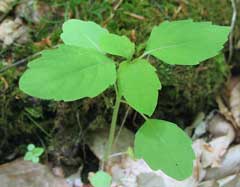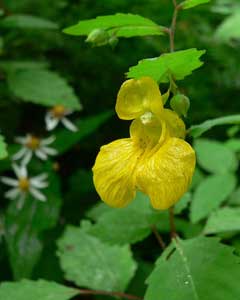 |
|
http://commons.wikimedia.org/wiki/User:Phyzome |
 |
| http://en.wikipedia.org/wiki/User:Arx_Fortis |
Translate this page:
Summary
Physical Characteristics

 Impatiens pallida is a ANNUAL growing to 1.5 m (5ft) by 0.6 m (2ft in).
Impatiens pallida is a ANNUAL growing to 1.5 m (5ft) by 0.6 m (2ft in).
See above for USDA hardiness. It is hardy to UK zone 8. The species is hermaphrodite (has both male and female organs) and is pollinated by Insects.
Suitable for: light (sandy), medium (loamy) and heavy (clay) soils, prefers well-drained soil and can grow in heavy clay soil. Suitable pH: mildly acid, neutral and basic (mildly alkaline) soils and can grow in very alkaline soils.
It can grow in semi-shade (light woodland) or no shade. It prefers moist soil.
UK Hardiness Map
US Hardiness Map
Synonyms
Plant Habitats
Woodland Garden Sunny Edge; Dappled Shade; Shady Edge; Bog Garden;
Edible Uses
Edible Parts: Leaves Seed Shoots
Edible Uses:
Young leaves and shoots - cooked[62]. Added to sukiyaki, chow mein and other oriental dishes[183]. When used as a vegetable on their own the cooking water should be changed once or twice during the cooking[183]. Some caution is advised, see the notes on toxicity at the top of the record. Seed[62]. No more details are given but the seeds are difficult to harvest in quantity, mainly because of their exploding seed capsules which scatter the ripe seed at the slightest touch[K].
References More on Edible Uses
Medicinal Uses
Plants For A Future can not take any responsibility for any adverse effects from the use of plants. Always seek advice from a professional before using a plant medicinally.
Skin Stings
The whole plant is diuretic, emetic and purgative[238]. It is only used externally, the soothing and medicinal sap is a proven remedy for nettle stings and poison ivy rash[62, 207, 222, 238, 257] and is also used in the treatment of warts, corns, ringworm and haemorrhoids[238].
References More on Medicinal Uses
The Bookshop: Edible Plant Books
Our Latest books on Perennial Plants For Food Forests and Permaculture Gardens in paperback or digital formats.

Edible Tropical Plants
Food Forest Plants for Hotter Conditions: 250+ Plants For Tropical Food Forests & Permaculture Gardens.
More

Edible Temperate Plants
Plants for Your Food Forest: 500 Plants for Temperate Food Forests & Permaculture Gardens.
More

More Books
PFAF have eight books available in paperback and digital formats. Browse the shop for more information.
Shop Now
Other Uses
Fungicide
A fungicide is obtained from the plant. It is used to treat skin diseases[62]. There are no more details but it is probably obtained from the fresh juice of the plant and can be concentrated by boiling up the juice.
Special Uses
References More on Other Uses
Cultivation details
Succeeds in any reasonably good soil[1]. Grows well in heavy clay soils. Prefers a moist well-drained humus rich soil in a cool site[200]. The plant is hardy to about -5°c[238]. It should be possible to grow it as a spring-sown annual in most parts of Britain. This plant has seed capsules that spring open forcibly as the seed ripens to eject the seed a considerable distance. The capsules are sensitive to touch even before the seed is ripe, making seed collection difficult but fun[K].
References Carbon Farming Information and Carbon Sequestration Information
Temperature Converter
Type a value in the Celsius field to convert the value to Fahrenheit:
Fahrenheit:
The PFAF Bookshop
Plants For A Future have a number of books available in paperback and digital form. Book titles include Edible Plants, Edible Perennials, Edible Trees,Edible Shrubs, Woodland Gardening, and Temperate Food Forest Plants. Our new book is Food Forest Plants For Hotter Conditions (Tropical and Sub-Tropical).
Shop Now
Plant Propagation
Seed - sow spring in a greenhouse. When they are large enough to handle, prick the seedlings out into individual pots and plant them out in the summer.
Other Names
If available other names are mentioned here
Native Range
NORTHERN AMERICA: Canada (Québec (south), Nova Scotia, Ontario (south), New Brunswick, Newfoundland and Labrador (southwest)), United States (Connecticut, Indiana, Maine, Massachusetts, Michigan, New Hampshire, New Jersey, New York, Ohio, Pennsylvania, Vermont, West Virginia, Illinois, Iowa, Kansas (east), Minnesota, Missouri, Nebraska, North Dakota (east), Oklahoma (northeast), South Dakota (east), Wisconsin, Colorado, Arkansas, Georgia (north), Kentucky, Maryland, North Carolina (west), Tennessee, Virginia)
Weed Potential
Right plant wrong place. We are currently updating this section.
Please note that a plant may be invasive in one area but may not in your area so it's worth checking.
Conservation Status
IUCN Red List of Threatened Plants Status :

Growth: S = slow M = medium F = fast. Soil: L = light (sandy) M = medium H = heavy (clay). pH: A = acid N = neutral B = basic (alkaline). Shade: F = full shade S = semi-shade N = no shade. Moisture: D = dry M = Moist We = wet Wa = water.
Now available:
Food Forest Plants for Mediterranean Conditions
350+ Perennial Plants For Mediterranean and Drier Food Forests and Permaculture Gardens.
[Paperback and eBook]
This is the third in Plants For A Future's series of plant guides for food forests tailored to
specific climate zones. Following volumes on temperate and tropical ecosystems, this book focuses
on species suited to Mediterranean conditions—regions with hot, dry summers and cool, wet winters,
often facing the added challenge of climate change.
Read More
Expert comment
Author
Nutt.
Botanical References
43
Links / References
For a list of references used on this page please go here
Readers comment
| Add a comment |
|
If you have important information about this plant that may help other users please add a comment or link below. Only comments or links that are felt to be directly relevant to a plant will be included. If you think a comment/link or information contained on this page is inaccurate or misleading we would welcome your feedback at [email protected]. If you have questions about a plant please use the Forum on this website as we do not have the resources to answer questions ourselves.
* Please note: the comments by website users are not necessarily those held by PFAF and may give misleading or inaccurate information.
To leave a comment please Register or login here All comments need to be approved so will not appear immediately.
|
Subject : Impatiens pallida
|
|
|
|